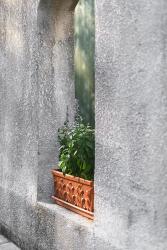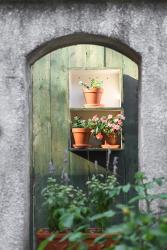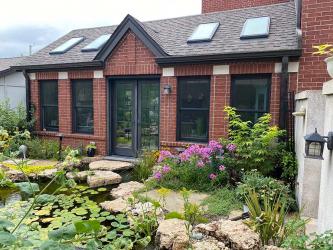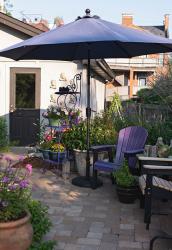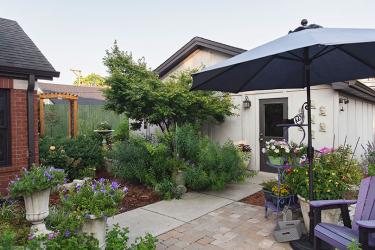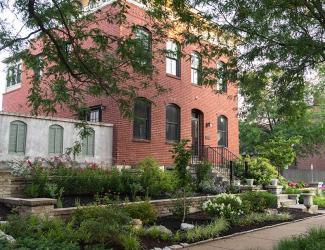Mark Kalk and his partner Mark Lammert had a problem. More succinctly, it was a landscaping problem. They needed to fit a large garden full of native plants and flowing water into a much smaller space. The reason why goes back a few years.
In 2010, then living in Compton Heights, they assembled four adjacent parcels of land into a one-third-acre site in iconic Lafayette Square, where they had once lived and still had friends. On that lot, they built a large, red brick townhome.
At first glance, you might assume the residence, just off the square itself, was one of the hundreds of beautifully restored historic homes that fill the area. It features the arched windows and doorways and elaborate cornices that keynote the period. Judging from the façade, there is little to indicate it is a beautifully designed imposter.
Mark and Mark had called on custom-builder Jason Walters of Stylecraft Homes and architect Jeff Day to take their ideas and turn them into a one-of-a-kind residence. Inside, the home artfully incorporates fine finishes with the latest in ecologically friendly construction and detailing. Outside, as well, the garden is ecologically friendly and unlike anything you would expect to see surrounding an historic townhouse.
Mark Kalk, a Master Gardener, who would go on to be named St. Louis Master Gardener of the year in 2014, envisioned and was instrumental in the construction of a pond and stream that wound through one of the empty parcels at the side of the house. Recently retired from the biology and life sciences department at Washington University, he landscaped the waterside garden space with approximately 100 different plant varieties, most of them Missouri natives that he explains “are adept at surviving in our nutty climate.”
Just off the house, Mark and Mark worked with the builder to create a series of “garden rooms.” The largest, a stone-floored, window-filled conservatory, is modeled on the historic Linnean (green) House at the Missouri Botanical Garden. Open to the garden; filled with plants that can be moved outdoors in warm weather, and centered with a long dining table, it provides a perfect entertainment space 12 months a year.
There is a decidedly Mediterranean, Tuscan influence in two other outdoor, stucco-walled spaces. Accented with arched and shuttered recesses, both display influences drawn from the Temperate House at the Botanical Garden. One, just off the home’s living room, is designed for entertaining and outdoor dining. The other, off the library, contains a single chair and is meant for quiet contemplation. Both also incorporate small garden beds and flower-filled containers.
“The big thing throughout the garden is flowers,” says Mark Kalk. “I like different shaped flowers and different colors. I’ve added things that bring color from early spring through October, sometimes even into November. If you do that you are providing plants for pollinators because that is what flowers are all about.”
The beauty and imagination of the original garden, fully mature by 2017, made it a natural for the prestigious Missouri Botanical Garden Garden Tour that year.
In 2019, Mark Kalk and Mark Lammert contemplated a move, along with family members, to Portland, Oregon. They bought a house in Portland, planning initially to divide their time between St. Louis and Portland. As time went on, they realized that if they were living in two places, they needed to downsize the St. Louis garden. When they were approached about selling off one of the parcels that made up their property, they agreed. The pond and the stream became the site for the new Lafayette Square townhome of their now next-door neighbors.
During this same time, the world was on COVID-19 lockdown. “Everybody got stuck,” Mark recalls. “Jobs changed, retirements changed. We were still early enough in the process to move everything back.” While a move to the Pacific Northwest may be in the future, Mark and Mark sold the Portland house and concentrated on living in St. Louis.
The entire process meant re-thinking their outdoor space and how to create a lush garden including the flowing water they had grown to love with approximately one-third of their lot missing. It was a big gardening problem.
Benches and pots went to friends and neighbors. So did clumps of native plants they had no space for. However, many such as purple and yellow coneflowers, native phlox, yarrow, Agastache/hyssop and Joe Pye weed found their way into the reduced garden.
Mark Kalk had personally dug out a great deal of the old water feature space himself, turning up vast amounts of old foundation stone, bricks, bottles, a car hood and amazingly a fully intact pack of cigarettes.
To design the new space Mark and Mark looked to Nature’s Re-Creations and Chris Siewing, whose work they had admired through magazine articles and during Pond-O-Rama water garden tours. They knew they needed help to transform the tight new space, just off the conservatory, into what they wanted.
“They initially wanted a garden bed between the waterfall, pond and the conservatory,” Chris recalls. “But after taking measurements and photographs on site, I couldn’t see a way to make it happen in that restricted space.” The dramatic and stunning solution involved “bringing the water right up to the door (of the conservatory).” That meant that anyone stepping outside the conservatory is literally walking over water. Massive, closely spaced, flat stones in the stream provide firm footing across small expanses of water and into the garden beyond. “It is a unique design, and I am glad they trusted me enough to do it,” says Chris, who even managed to wedge in a shallow dog beach for Mark and Mark’s terrier Penny.
While it appears that the stream is lapping at the foundation of the house, it is actually contained within a liner, artfully concealed by Pennsylvania bluestone at the doorsill and below the waterline. The pond and stream are tilted slightly so that in heavy rains, excess water flows into a slightly depressed rain garden, planted with water-loving flowers and greenery.
Despite the small space and the amount of hardscape, the garden appears full and lush. “Through the years, I’ve learned about the technique of ‘over planting,’” explains Mark Kalk. “Not making a mess of things but putting plants closer together so you don’t have as much space between them. It’s an adaptation on natural planting.” He has found golden creeping jenny works well as a ground cover in any remaining bare spots.
For added color Mark fills pots with spider flowers, Mexican heather, geraniums and flowing blue evolvulus, all of which can be taken inside when the weather gets cold. To add height, he uses native, non-invasive yellow and coral honeysuckles on trellises. Despite its small footprint and city location, the number of native plants and amount of flowing water in the garden qualify it to be a Certified Wildlife Habitat by the National Wildlife Federation
The corner lot allows visitors to the garden to enter through a back gate off the alley. It is the way Mark prefers. “What you see is the size of a typical yard for a city garden surrounding Lafayette Square,” he notes. But follow the mulched path and turn the corner and a water wonderland and trip to the Mediterranean provide a complete surprise.





